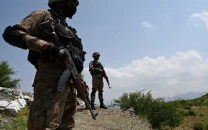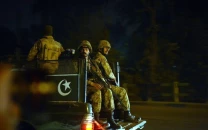The name of the rose

My grandfather’s house is on the south side of this enclosed sarai an “alam” flies above it from the rooftop, signalling the reverence felt by this family of Syeds to the family of the Prophet Mohammad (pbuh) and his son-in-law, Hazrat Ali. On the north side of the compound is an incongruent cement and marble block which serves at once as a community centre as well as a shaadi hall, circa the twentieth century.
Right beside the eastern gate of Gor Khutree is the fire engine parked by the British administrators of this glorious city under their governor, General Avitabile (1838-1842), whose plaque is still fixed at the exterior of the western gate. The British rulers converted Gor Khutree into a reserve police station, fire brigade headquarter and a revenue record office in 1912. Within the compound, once a place of Hindu and Buddhist worship, is the Goraknath temple of the Sikh period in the south-western part, standing steadfast in the shade of a magnificent banyan tree.
A series of cells runs along the wall across the street from our ancestral haveli. Characterised by stately Mughal arches, these cells hold within them the memories of several thousand years of history and collective human endeavour. Gor Khutree had been identified by Sir Alexander Cunningham as the Kanishka Vihara (the monastery of King Kanishka’s Great Stupa at Shah-ji-ki-Dheri) and by Dr Ahmad Hassan Dani as a place where the tower of the Buddha’s alms bowl once stood. History tells us that the Mughal emperor Babur visited the place and recorded its importance in his autobiography.
The temple has been mentioned by emperors Akbar and Jehangir as the most famous shrine of the Gorakh Nathi movement. Jehan Ara Begum, the daughter of Emperor Shahjehan converted the site into a caravan sarai in 1641 and named it Sarai Jahanabad. She also constructed a grand mosque, bathing facilities and two wells inside the sarai. Only in memory can we find references to the people who lived and worked here, for in the renaming of this wondrous province, those who built the city, who laid out the streets, who crafted the homes, who sang ancient melodies, who lived and died here, do not figure in the myopia which forbids political expediency to see how deep still waters run. That shifting demographics should determine the “character” of a province is indeed tragic, for in playing by the game of numbers, the leadership of dominant political groups takes the risk of alienating, indeed, denying the inalienable rights of those who do not constitute the “majority”. What role that “minority” has played in the formation of an ever-evolving cultural identity seems to become subsumed in the one-dimensional numbers game which has been described as inherent to the democratic process. Whether that process has indeed been predicated on the basic principles of democracy, that is, equal citizenship, equal rights and a respect for diversity is open to debate.
After all, in a polity scarred with the oppression of feudalism which enables its scions to “represent” the people largely because they wield unchecked power, equality of rights and opportunities is still a dream. My father’s city has been asked to deny the thousands of years of history which can be witnessed in the archaeological dig at Gor Khutree where virgin soil has still not been unearthed. Evidence that this was a flourishing city during the reign of the Maurya’s (late fourth-third centuries BC) has been found.
That Peshawar has been known as Purushapura, Purshapura, Purshpur, Purshawar, Pishawar, Purshur, Farashabur and Begram is irrelevant now, for when is a rose not a rose? Only if someone changes its name?



















COMMENTS
Comments are moderated and generally will be posted if they are on-topic and not abusive.
For more information, please see our Comments FAQ